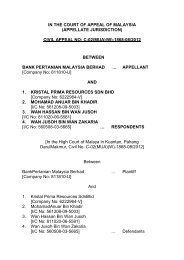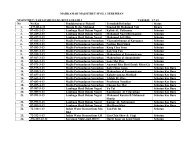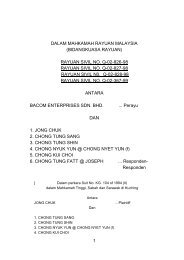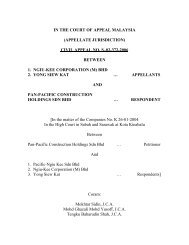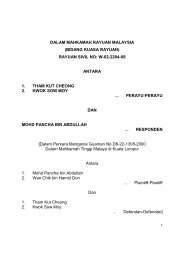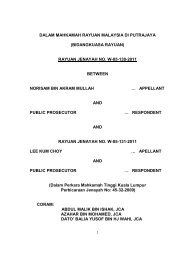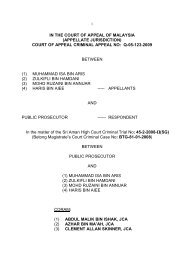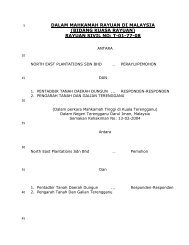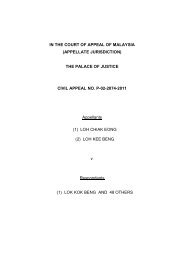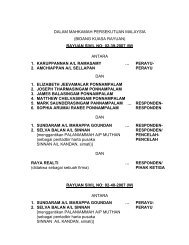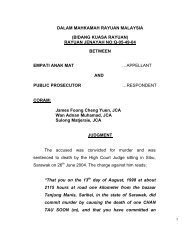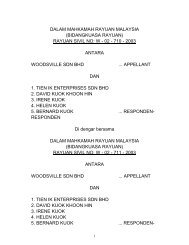rayuan jenayah no: a-05-120-2009 antara mohd kamal bin osman
rayuan jenayah no: a-05-120-2009 antara mohd kamal bin osman
rayuan jenayah no: a-05-120-2009 antara mohd kamal bin osman
Create successful ePaper yourself
Turn your PDF publications into a flip-book with our unique Google optimized e-Paper software.
1<br />
DALAM MAHKAMAH RAYUAN MALAYSIA<br />
(BIDANG KUASA RAYUAN)<br />
RAYUAN JENAYAH NO: A-<strong>05</strong>-<strong>120</strong>-<strong>2009</strong><br />
ANTARA<br />
MOHD KAMAL BIN OSMAN ---- PERAYU<br />
DAN<br />
PENDAKWA RAYA ---- RESPONDEN<br />
Dalam Mahkamah Tinggi Malaya Di Taiping<br />
Perbicaraan Jenayah No: 58-13-2001<br />
CORAM:<br />
Pendakwa Raya<br />
lawan<br />
Mohd Kamal <strong>bin</strong> Osman<br />
(1) HASAN BIN LAH, JCA<br />
(2) ABDUL MALIK BIN ISHAK, JCA<br />
(3) SYED AHMAD HELMY SYED AHMAD, JCA
Introduction<br />
2<br />
ABDUL MALIK BIN ISHAK, JCA<br />
DELIVERING THE JUDGMENT OF THE COURT<br />
[1] Before the Taiping High Court, the appellant was charged for an<br />
offence of trafficking in dangerous drugs, to wit, 4,089 grammes of<br />
cannabis, an offence under section 39B(1)(a) of the Dangerous Drugs Act<br />
1952 (“DDA”) and punishable under section 39B(2) of the DDA. The<br />
charge against the appellant reads as follows:<br />
“Bahawa kamu pada 28.2.2001 jam lebih kurang 8.40 malam di Batu 2<br />
½ Jalan Simpang, Taiping di dalam Daerah Larut Matang dan Selama<br />
di dalam Negeri Perak, telah didapati mengedar dadah berbahaya<br />
iaitu 4,089 gram cannabis dan oleh yang demikian kamu telah<br />
melakukan suatu kesalahan di bawah seksyen 39B(1)(a) Akta Dadah<br />
Berbahaya 1952 dan boleh dihukum di bawah seksyen 39B(2) Akta<br />
yang sama.”<br />
[2] At the close of the case for the prosecution, the learned High<br />
Court Judge evaluated the evidence on a maximum evaluation and found<br />
that the prosecution had succeeded in proving a prima facie case sufficient<br />
to convict the appellant even if the appellant elected to remain silent and<br />
his Lordship then called for the defence of the appellant under section<br />
39B(1)(a) of the DDA and punishable under section 39B(2) of the DDA<br />
(Looi Kow Chai & A<strong>no</strong>r v PP [2003] 2 MLJ 65, [2003] 2 AMR 89; and<br />
Balachandran v PP [20<strong>05</strong>] 1 CLJ 85).
3<br />
[3] The appellant elected to give his evidence under oath and he<br />
called <strong>no</strong> other witnesses. The learned High Court Judge, at the end of the<br />
trial, found that the appellant had failed to create a reasonable doubt in the<br />
prosecution’s case and convicted him accordingly. The appellant was<br />
sentenced to death by hanging. Aggrieved, the appellant <strong>no</strong>w appeals to<br />
this Court.<br />
The prosecution’s case<br />
[4] Within a narrow compass, the prosecution’s case may be stated<br />
as follows. On 28.2.2001, ASP Iyeng a/l Ending Niang (SP4) attended a<br />
briefing conducted by ASP Razali from the narcotics division of the Taiping<br />
district headquarters pertaining to an information that a target riding a<br />
motorcycle bearing registration number AEB 2680 from Kuala Kurau to<br />
Taiping would be trafficking drugs. In that briefing, which was also attended<br />
by Detective Sergeant Major 63152 Ali <strong>bin</strong> Shafie (SP5) and other police<br />
personnel, ASP Razali divided the members of the police party into three<br />
teams.<br />
[5] Approximately at 7.00 p.m., SP4 who drove a motor car together<br />
with his team which included SP5 arrived at the surveillance area which<br />
was near a traffic light at Simpang Empat, Semanggol and waited. At<br />
about 8.15 p.m., SP4 saw a man – the target, riding alone on a motorcycle<br />
bearing registration number AEB 2680 coming from the direction of Bagan
4<br />
Serai area and heading towards Taiping. As the motorcycle in question<br />
ridden by the target went past SP4, SP4 saw a black coloured plastic bag<br />
(exhibit “P5C”) in the carrier basket of the said motorcycle. SP4<br />
immediately used a handset to contact and alert Inspector Ng Wei Boon to<br />
tail the said motorcycle. At that time, the said Inspector was leading team<br />
number 3 in a<strong>no</strong>ther motor car and was located by the road side of<br />
Simpang Empat near to the Kamunting toll. The said Inspector and his<br />
team tailed the said motorcylist – the target, from behind. SP4, who was<br />
driving a motor car, followed suit.<br />
[6] When the target arrived near the Kamunting traffic lights, he<br />
stopped his motorcycle. SP4 also stopped his motor car alongside the<br />
motorcycle and he saw, once again, the black coloured plastic bag (exhibit<br />
“P5C”) in the carrier basket of the said motorcycle. When the traffic light<br />
turned green, the target continued riding his motorcycle towards the<br />
direction of Simpang, Taiping. SP4 continued to follow the target. At 2½<br />
milestone, Jalan Simpang, Taiping, SP4 ordered the target to stop his<br />
motorcycle by overtaking and hemming him to the side of the road and at<br />
the same time shouting the word “Polis” at the target. This forced the<br />
target to stop his motorcycle by the side of the road. SP4 quickly alighted<br />
from his motor car and wanted to check the target (<strong>no</strong>w identified as the<br />
appellant). But the appellant tried to run away and his motorcycle also fell.
5<br />
[7] SP4 succeeded in apprehending the appellant with the assistance<br />
of the other members of the police party.<br />
[8] SP4 conducted a body search on the appellant but <strong>no</strong>thing<br />
incriminating was found on him. SP4 then examined the motorcycle in the<br />
presence of the appellant and the police party and found a black coloured<br />
plastic bag (exhibit “P5C”) in the carrier basket of the motorcycle ridden<br />
by the appellant. The photograph at page 145 of the appeal record shows<br />
the black coloured plastic bag with the drugs in question.<br />
[9] When SP4 opened the black coloured plastic bag (exhibit “P5C”),<br />
he found four (4) compressed slabs of plant materials suspected to be<br />
cannabis. SP4 also detected the pungent smell of the cannabis emanating<br />
from the black coloured plastic bag (exhibit “P5C”).<br />
[10] The evidence of SP4 was amply corroborated by SP5. SP5<br />
travelled in the said motor car with SP4 and SP5 gave a running<br />
commentary on similar terms like SP4 in regard to the narration of the<br />
events preceding the arrest of the appellant. SP5 emphasised that the<br />
appellant rode the said motorcycle alone throughout the episode and that<br />
the appellant tried to run but was duly arrested.<br />
[11] In due course the government chemist – Miss Lam Yoke Ching<br />
(SP6), confirmed that the four (4) compressed slabs of plant materials to be
6<br />
cannabis, a dangerous drug within the meaning of the DDA, weighing<br />
4,089 grammes.<br />
[12] Chief Inspector A. Aziz <strong>bin</strong> Setapa (SP3) testified that the<br />
motorcycle belonged to the appellant’s wife.<br />
The defence<br />
[13] The appellant, a fisherman by profession, testified that upon his<br />
return from fishing in the evening of 28.2.2001, he received a telephone call<br />
from his wife. At that time, his wife had gone to visit a sick relative at the<br />
Taiping Hospital and she wanted to go home and she asked him to fetch<br />
her there.<br />
[14] The appellant then left his house and proceeded to take his<br />
wife’s motorcycle (exhibit “P11”) that was parked under the house of his<br />
brother-in-law. The area wherein the motorcycle was parked was an open<br />
area and anyone could have access to it. The appellant testified that he left<br />
at about 6.00 p.m. to fetch his wife at the Taiping Hospital.<br />
[15] According to the appellant, his wife always used the motorcycle<br />
(exhibit “P11”). Apart from his wife that often used the said motorcycle, his<br />
younger brother-in-law by the name of Sazali also used the said<br />
motorcycle. Sometimes, according to him, the neighbours would borrow the<br />
said motorcycle. The appellant ventured to say that he hardly used the said<br />
motorcycle and that he <strong>no</strong>rmally used a bicycle.
7<br />
[16] When the appellant was about to ride the said motorcycle, he<br />
saw a black coloured plastic bag (exhibit “P5C”) in the carrier basket of<br />
the said motorcycle. He said that he did <strong>no</strong>t open the black coloured plastic<br />
bag (exhibit “P5C”) because he thought that it was a rain coat belonging to<br />
his wife. He said that he often see his wife kept two raincoats in the carrier<br />
basket of the said motorcycle for herself and for their child. He testified that<br />
the black coloured plastic bag (exhibit “P5C”) was like the ones marked as<br />
exhibits “P6B” and “P6C” in the photographs at pages 144 and 145 of the<br />
appeal record respectively.<br />
[17] When they introduced themselves as “Polis”, the appellant said<br />
that he was still seated astride the motorcycle. Then two male persons<br />
approached him to his right and one female person flanked him to his left.<br />
He was directed to alight from the motorcycle. Both his hands and legs<br />
were handcuffed (“Tangan dan kaki saya digari”) – see page 78 of the<br />
appeal record when the appellant gave evidence at the examination-in-<br />
chief stage.<br />
[18] He denied that, at any time, he tried to escape.<br />
[19] According to him, the police examined the carrier basket of the<br />
motorcycle and took out a black coloured plastic bag (exhibit “P5C”). The<br />
police open the black coloured plastic bag (exhibit “P5C”) in his presence<br />
and told him that it contained “ganja”.
8<br />
[20] According to him, the last time he used the motorcycle was two<br />
or three weeks before the incident.<br />
Analysis<br />
[21] We will <strong>no</strong>w proceed to examine the grounds set forth in the<br />
Petition of Appeal. We will begin by making reference to ground two of the<br />
Petition of Appeal which alluded to the failure of the learned High Court<br />
Judge to invoke the adverse inference against the prosecution for the <strong>no</strong>n-<br />
calling of the appellant’s wife by the name of Salmah bt Omar being the<br />
registered owner of motorcycle bearing registration number AEB 2680 that<br />
was ridden by the appellant on that fateful night.<br />
[22] It is apparent that the prosecution elected <strong>no</strong>t to call Salmah bt<br />
Omar – the wife of the appellant and the registered owner of the said<br />
motorcycle, as a witness for the prosecution. Nevertheless, Salmah bt<br />
Omar was offered as a witness to the defence at the close of the<br />
prosecution’s case. The prosecution held the view that Salmah bt Omar is<br />
<strong>no</strong>t a material witness essential to the unfolding of the narration of the<br />
prosecution’s version of the events that took place on that fateful night,<br />
namely, on 28.2.2001 at about 8.40 p.m. at the place mentioned in the<br />
charge.<br />
[23] Both SP4 and SP5 narrated that they saw the appellant was<br />
riding alone on the said motorcycle before he was apprehended. The Court
9<br />
is <strong>no</strong>t concerned as to the ownership of the said motorcycle but rather the<br />
possession of the black coloured plastic bag (exhibit “P5C”) that contained<br />
the dangerous drugs found in the carrier basket of the said motorcycle.<br />
[24] The learned High Court Judge rightly referred to the Court of<br />
Appeal case of PP v. Letchumanan Suppiah [2006] 1 CLJ 557 and his<br />
Lordship then decided that section 114(g) of the Evidence Act 1950 did <strong>no</strong>t<br />
apply and it can<strong>no</strong>t be invoked against the prosecution for the <strong>no</strong>n-calling<br />
of the appellant’s wife. We are concerned here with the custody and control<br />
of the black coloured plastic bag (exhibit “P5C”) found in the carrier basket<br />
of the motorcycle which can<strong>no</strong>t be related to the ownership of the<br />
motorcycle on which the appellant was riding. That black coloured plastic<br />
bag (exhibit “P5C”) was within sight of the appellant as he rode the said<br />
motorcycle on that fateful day. There was <strong>no</strong>t even an iota of evidence<br />
linking the appellant’s wife to the drugs at all. There was <strong>no</strong> cross-<br />
examination of SP4 and SP5 that the drugs belonged to the appellant’s<br />
wife.<br />
[25] The prosecution’s case hinged on the evidence of SP4 whose<br />
evidence was corroborated by SP5. The totality of the evidence led by the<br />
prosecution pointed solely to the culpability of the appellant. No one else<br />
was involved. It is our judgment, even without calling the appellant’s wife,
10<br />
the prosecution has succeeded in establishing a prima facie case against<br />
the appellant.<br />
[26] Salmah bt Omar – the appellant’s wife, is <strong>no</strong>t a witness<br />
“essential to the unfolding of the narratives on which the prosecution<br />
case is based” (per Lord Roche in Seneviratne v R [1936] 3 All ER 36)<br />
and she is also <strong>no</strong>t an “important and material witness to the case” (per<br />
Mohamed Azmi SCJ in Munusamy v PP [1987] 1 MLJ 492). In our<br />
judgment, the appellant’s wife do <strong>no</strong>t belong to the class of witnesses<br />
described by Lord Roche and Mohamed Azmi SCJ in those two cases so<br />
as to warrant her to be called.<br />
[27] We will <strong>no</strong>w consider grounds four, five and six of the Petition of<br />
Appeal together. They concerned the invocation of the double<br />
presumptions under sections 37(d) and 37(da) of the DDA in the<br />
prosecution’s case and the usage of section 2 of the DDA to prove<br />
trafficking. We have perused through the written grounds of judgment of the<br />
learned High Court Judge and we are constrained to hold that his Lordship<br />
did <strong>no</strong>t resort to using both the presumptions in his judgment. From the<br />
authorities which his Lordship referred to, it is clear that his Lordship<br />
resorted to section 37(d) of the DDA to presume k<strong>no</strong>wledge against the<br />
appellant and his Lordship then referred to section 2 of the DDA to show<br />
that the prosecution had succeeded in proving trafficking. This approach
11<br />
was sanctioned by the Federal Court in PP v. Abdul Manaf Muhamad<br />
Hassan [2006] 2 CLJ 129 where Arifin Zakaria FCJ (<strong>no</strong>w Chief Justice of<br />
Malaysia) writing for the Federal Court at page 144 of the report succinctly<br />
said:<br />
“(17) It ought to be stated at the outset that the decision in<br />
Muhammed <strong>bin</strong> Hassan only prohibits the use of double<br />
presumptions under ss. 37(d) and 37(da) of the Act. It is, therefore,<br />
open to the prosecution to rely on either of the presumptions. In<br />
other words, the prosecution may positively prove possession<br />
without relying on the presumption under s. 37(d) of the Act and go<br />
on to rely on the presumption of trafficking under s. 37(da) of the Act<br />
to support a charge under s. 39B of the Act. See Tunda Apatira &<br />
Ors. v. Public Prosecutor (supra); Msimanga Lesaly v. Public<br />
Prosecutor [20<strong>05</strong>] 1 CLJ 398 (a decision of the Court of Appeal which<br />
was confirmed by this court in Federal Court Criminal Appeal No: <strong>05</strong>-<br />
27-2004(K). Conversely, the prosecution may rely on the<br />
presumption under s. 37(d) to prove possession and seek to prove<br />
by affirmative evidence (independent of the presumption under s.<br />
37(da)) that the accused was in fact trafficking in the dangerous<br />
drug.”<br />
[28] A review of the evidence would show that when the proscribed<br />
drugs were found and seized from the appellant on that fateful night, the<br />
appellant was in possession of the said drugs. At this juncture, it is<br />
germane to refer to the case of Public Prosecutor v. Chan Ah Kow &<br />
A<strong>no</strong>r [1988] 2 CLJ (Rep) 186, a decision of KC Vohrah J which was also<br />
referred to by the learned High Court Judge. In that case, the second<br />
accused who was riding the motorcycle had control of the motorcycle<br />
where the red plastic bag containing the drugs were placed inside the<br />
carrier basket and due to the proximity between the second accused and
12<br />
the carrier basket, the Court held that the second accused was in<br />
possession of the offending drugs by virtue of section 37(d) of the DDA. In<br />
regard to k<strong>no</strong>wledge, at page 194 of the report, KC Vohrah J had this to<br />
say:<br />
“Why would the motor cyclist, the accused, attempt to escape unless<br />
he knew the package he was carrying was <strong>no</strong>n-in<strong>no</strong>cent. There is <strong>no</strong><br />
dispute that the red plastic bag was in the motor cycle basket<br />
between his legs. In my view <strong>no</strong> doubt has been created on the<br />
prosecution’s case as regards the police identification, the accused<br />
being the motor cyclist, he attempting to run away, and the discovery<br />
of the bag of drugs in the motor cycle basket between his legs<br />
affirming that he had control of the drugs.”<br />
[29] Here, there was evidence that both SP4 and SP5 saw the<br />
appellant riding the said motorcycle with a black coloured plastic bag<br />
(exhibit “P5C”) containing the four (4) compressed slabs of plant materials<br />
suspected to be cannabis for quite a distance and tailing the appellant<br />
before he was apprehended at the place mentioned in the charge. The<br />
appellant also attempted to abscond when confronted by SP4 and the<br />
police party. The excerpts of the evidence of SP4 at pages 44 to 45 of the<br />
appeal record are solid evidence of the appellant’s attempt at absconding:<br />
“Sasaran (referring to the appellant) cuba hendak melarikan diri<br />
dengan cuba membelok motosikal keluar semula ke jalan. Saya<br />
berjaya menahan sasaran (referring to the appellant). Pada masa<br />
yang sama pasukan bermotosikal pun sampai dan membantu saya.”
13<br />
[30] Likewise SP5 also testified to the same effect pertaining to the<br />
appellant’s unsuccessful attempt at escaping (see page 57 of the appeal<br />
record):<br />
“Apabila sampai di Batu 2 ½, Simpang, ASP Iyeng (referring to SP4)<br />
telah menghimpit motosikal ke tepi kiri jalan. Motosikal itu berhenti.<br />
ASP Iyeng (referring to SP4) dan saya turun dari kereta dan cuba<br />
menangkap lelaki tersebut. Lelaki tersebut cuba melarikan diri.<br />
Belum sempat ia melarikan diri, dengan bantuan anggota lain<br />
sasaran (referring to the appellant) telah ditangkap.”<br />
[31] Both SP4 and SP5 are credible witnesses and they corroborated<br />
one a<strong>no</strong>ther. Raja Azlan Shah CJ (Malaya) (as His Royal Highness then<br />
was) in Yap Ee Kong & A<strong>no</strong>r v. Public Prosecutor [1981] 1 MLJ 144,<br />
146, FC, emphasised that the corroborative evidence must be credible:<br />
“In such a situation the principles enunciated by Lord Morris of<br />
Borth-y-Gest in Director of Public Prosecutions v Hester [1973] AC<br />
296, 315 should be applied:<br />
‘The essence of corroborative evidence is that one creditworthy witness<br />
confirms what a<strong>no</strong>ther creditworthy witness has said ..... The purpose of<br />
corroboration is <strong>no</strong>t to give validity or credence to evidence which is<br />
deficient or suspect or incredible but only to confirm and support that<br />
which as evidence is sufficient and satisfactory and credible: and<br />
corroborative evidence will only fill its role if it itself is completely credible<br />
evidence’.”<br />
[32] K<strong>no</strong>wledge on the part of the appellant in regard to the contents<br />
of the black coloured plastic bag (exhibit “P5C”), on the facts of the<br />
present appeal, must be judged from the outward conduct of the appellant.<br />
In Ong Ah Chuan v. Public Prosecutor, Koh Chai Cheng v. Public
14<br />
Prosecutor [1981] 1 MLJ 64, 69, Lord Diplock had this to say about proof<br />
of k<strong>no</strong>wledge by way of an inference:<br />
“Proof of the purpose for which an act is done, where such purpose<br />
is a necessary ingredient for the offence with which an accused is<br />
charged, presents a problem with which criminal courts are very<br />
familiar. Generally, in the absence of an express admission by the<br />
accused, the purpose with which he did an act is a matter of<br />
inference from what he did.”<br />
[33] Augustine Paul J (later FCJ) in Mohd Farid <strong>bin</strong> Mohd Sukis &<br />
A<strong>no</strong>r [2002] 3 AMR 3457; [2002] 3 MLJ 401, after citing a few authorities,<br />
observed that “proof of k<strong>no</strong>wledge is very often a matter of inference”.<br />
[34] Again, the same learned Judge observed in Public Prosecutor<br />
v Reza Mohd Shah <strong>bin</strong> Ahmad Shah [2002] 4 MLJ 13, at page 20:<br />
“There are many circumstances from which k<strong>no</strong>wledge can be<br />
inferred. One instance is the inference to be drawn from the act of a<br />
person in absconding or fleeing from the scene of a crime.”<br />
[35] We pause here to state categorically that in the context of the<br />
present appeal, the very act of the appellant in attempting to run after<br />
hearing SP4 shouted the word “Polis” was sufficient to conclude that the<br />
appellant had possession of the drugs found in the black coloured plastic<br />
bag (exhibit “P5C”) that was put inside the carrier basket of the said<br />
motorcycle even without resorting to the presumption under section 37(d)<br />
of the DDA.
15<br />
[36] Here, the learned High Court Judge indirectly relied on section<br />
37(d) of the DDA without specifically mentioning it after his Lordship<br />
alluded to the case of Public Prosecutor v. Chan Ah Kow (supra).<br />
[37] On the issue of possession, we need to refer to some authorities.<br />
[38] In the Federal Court case of PP v. Abdul Rahman Akif [2007] 4<br />
CLJ 337; [2007] 5 MLJ 1, Arifin Zakaria FCJ (<strong>no</strong>w Chief Justice of<br />
Malaysia) discussed the element of possession in relation to the drugs<br />
found in packages under the seats of a car driven by the accused and also<br />
considered the views of Thomson J in Chan Pean Leon v Public<br />
Prosecutor [1956] 22 MLJ 237 and that of Shankar J in Pendakwa Raya<br />
v Kang Ho Soh [1991] 3 CLJ 2913 as well as the Singapore case of Lim<br />
Beng Soon v Public Prosecutor [2000] 4 SLR 589 and held that the<br />
presence of the three packages in the car without a plausible explanation<br />
from the respondent could give rise to a strong inference that he had<br />
k<strong>no</strong>wledge that the packages contained drugs or things of similar nature.<br />
[39] This would be followed by two authorities emanating from<br />
Singapore. The first would be the case of Ramis a/l Muniandy v PP [2001]<br />
3 SLR 534. There Ramis was seen riding a motorcycle along the Marsiling<br />
Industrial Estate. The Central Narcotics Bureau (“CNB”) officers saw him<br />
parking his motorcycle at the parking lots next to Block 7. Ramis was then<br />
seen walking towards Marsiling Rise and stopping at the front of Block 7.
16<br />
Ramis was also seen using his mobile and he was then arrested by the<br />
CNB officers in front of Block 7 and was then taken to his parked<br />
motorcycle. The CNB officers searched Ramis’s motorcycle and found a<br />
“Puma” bag which contained drugs. Evidence was also adduced that the<br />
motorcycle belonged to Ramis. At page 541, Yong Pung How (Chief<br />
Justice of Singapore) aptly said:<br />
“K<strong>no</strong>wledge of drugs<br />
The starting point in the consideration of this issue was that we had<br />
already concluded that the drugs was already on Ramis’s motorcycle<br />
when he entered the vicinity and that he had physical control of the<br />
drugs. In the absence of any reasonable explanation by Ramis, these<br />
facts were sufficient to lead to a strong inference that Ramis knew<br />
that the bag found on his motorcycle contained drugs.”<br />
[40] The second case would be that of Tan Ah Tee & A<strong>no</strong>r v PP<br />
[1980] 1 MLJ 49, where Wee Chong Jin (Chief Justice of Singapore)<br />
delivering the judgment of the Court had this to say at page 52 of the<br />
report:<br />
“Indeed, even if there were <strong>no</strong> statutory presumptions available to<br />
the prosecution, once the prosecution had proved the fact of<br />
physical control or possession of the plastic bag and the<br />
circumstances in which this was acquired by and remained with the<br />
second appellant, the trial judges would be justified in finding that<br />
she had possession of the contents of the plastic bag within the<br />
meaning of the Act unless she gave an explanation of the physical<br />
fact which the trial judges accepted or which raised a doubt in their<br />
minds that she had possession of the contents within the meaning of<br />
the Act.”<br />
[41] It is pertinent to mention that both the Singapore cases were<br />
alluded to by our Federal Court in PP v. Abdul Rahman Akif (supra).
17<br />
[42] We will <strong>no</strong>w reproduce the definition of the word “trafficking” as<br />
set out in section 2 of the DDA. It contains a gamut of acts that constitutes<br />
“trafficking”:<br />
“ ‘trafficking’ includes the doing of any of the following acts, that is<br />
to say, manufacturing, importing, exporting, keeping, concealing,<br />
buying, selling, giving, receiving, storing, administering,<br />
transporting, carrying, sending, delivering, procuring, supplying or<br />
distributing any dangerous drug otherwise than under the authority<br />
of this Act or the regulations made under the Act.”<br />
[43] The word “transporting” was employed by the learned High<br />
Court Judge to describe the acts of the appellant in transporting the drugs<br />
and with full k<strong>no</strong>wledge of trafficking in those drugs. His Lordship also held<br />
that the quantity of the drugs indicated that it was <strong>no</strong>t meant for the<br />
appellant’s own consumption. At page 24 of the appeal record, this was<br />
what his Lordship said:<br />
“Seterusnya Mahkamah ini berpuashati bahawa Tertuduh pada<br />
ketika itu sedang membawa (transporting) ganja tersebut dengan<br />
sepenuh pengetahuannya bagi tujuan mengagih atau mengedar<br />
ganja sebanyak 4,089 gram. Jumlah ganja yang banyak itu iaitu 20<br />
kali lebih besar dari peruntukan statutory juga menunjukkan ganja<br />
tersebut bukan untuk kegunaan Tertuduh sendiri.”<br />
[44] The evidence irresistibly points to the appellant transporting the<br />
drugs in the carrier basket of the motorcycle ridden by him. That would be a<br />
clear cut case of trafficking.<br />
[45] The learned deputy public prosecutor submitted that even if<br />
there was a misdirection by the learned High Court Judge, the conviction in
18<br />
this appeal is safe and should be upheld as there is overwhelming<br />
evidence against the appellant and that a reasonable tribunal properly<br />
appraised of the available evidence and properly directed itself in<br />
accordance with the decision of the Federal Court in Tunde Apatira & Ors<br />
v Public Prosecutor [2001] 1 MLJ 259 would convict the appellant for<br />
trafficking in the dangerous drugs as per the charge.<br />
[46] It seems to us that the learned deputy public prosecutor is<br />
imploring us to invoke and apply vigorously the proviso to section 60(1) of<br />
the Courts of Judicature Act 1964 which enacts as follows:<br />
“Provided that the Court of Appeal may, <strong>no</strong>twithstanding that it is of<br />
opinion that the point raised in the appeal might be decided in favour<br />
of the appellant, dismiss the appeal if it considers that <strong>no</strong> substantial<br />
miscarriage of justice has occurred.”<br />
[47] The full bench of the Federal Court in Tunde Apatira’s case<br />
(supra), at page 266 had this to say:<br />
“So it comes to this. As a general rule this court will, in the <strong>no</strong>rmal<br />
course of events, quash a conviction where there has been a<br />
misdirection. Exceptionally, a conviction will be upheld despite a<br />
misdirection where this court is satisfied, that a reasonable tribunal<br />
would have convicted the accused on the available evidence on a<br />
proper direction. The decision of this court in Alcontara al/ Ambross<br />
Anthony v PP [1996] 1 MLJ 209 exemplifies the general rule, while<br />
that in Khoo Hi Chiang v PP [1994] 1 MLJ 265 illustrates the<br />
exception.”<br />
[48] The Federal Court in Tunde Apatira (supra) clearly said that the<br />
proviso to section 60(1) of the Courts of Judicature Act 1964 is only<br />
applicable to those cases which are to be considered “exceptional”. The
19<br />
burden is always on the prosecution to show that the evidence is<br />
“overwhelming”. Here, the learned High Court Judge at the prima facie<br />
stage was satisfied that the appellant was in possession of the cannabis<br />
weighing 4,089 grammes. That, in our judgment, is indicative of the<br />
overwhelming evidence adduced by the prosecution and it would trigger the<br />
proviso in favour of the prosecution. Since there is <strong>no</strong> substantial<br />
miscarriage of justice, the conviction stays and it is safe to convict the<br />
appellant.<br />
[49] In regard to grounds eight, nine, ten and eleven of the Petition of<br />
Appeal that concerned the averments that the learned High Court Judge<br />
failed to adequately consider the appellant’s defence, we have this to say.<br />
A perusal of the written grounds of judgment of his Lordship showed that<br />
the defence of the appellant was considered and analysed as seen at<br />
pages 18 to 23 of the appeal record. Having considered the defence, his<br />
Lordship was of the opinion that the defence raised by the appellant failed<br />
to create a reasonable doubt in the prosecution’s case.<br />
[50] It must be emphasised that the learned High Court Judge did <strong>no</strong>t<br />
invoke an adverse inference against the appellant for <strong>no</strong>t calling his wife as<br />
a witness. His Lordship merely stated that the appellant’s evidence was<br />
weaker without the support of his wife’s testimony. And this was criticised<br />
by learned defence counsel as a misdirection in law and that the appellant
20<br />
was prejudiced. Reliance was then placed on the case of Alcontara a/l<br />
Ambross Anthony v Public Prosecutor [1996] 1 MLJ 209, FC. But,<br />
factually speaking Alcontara’s case are poles apart from the present<br />
appeal. In Alcontara, the cautioned statement was made one day after his<br />
arrest and in it he mentioned about Che Mat, and Che Mat’s telephone<br />
number and place of abode. Here, in the present appeal, there was <strong>no</strong><br />
cautioned statement at all.<br />
[51] Learned defence counsel argued that the defence put up by the<br />
appellant was a reasonable defence. And that the appellant had explained<br />
about the two raincoats. It was, according to learned defence counsel, a<br />
case of mere possession. In regard to the two raincoats, we have this to<br />
say. The search list marked as exhibit “P8” as found at page 154 of the<br />
appeal record made <strong>no</strong> mention of any raincoat at all. The photographs at<br />
pages 143 to 149 do <strong>no</strong>t show the existence of the two raincoats as alleged<br />
by the appellant.<br />
[52] Finally, a<strong>no</strong>ther point worth <strong>no</strong>ting is this. SP4 lodged a police<br />
report on 28.2.2001 – the very day when the offence was committed. And<br />
that police report marked as exhibit “P10” was lodged at about 10.10 p.m.<br />
It showed consistency and was <strong>no</strong>t at variance with the evidence of SP4<br />
during the trial. That police report (exhibit “P10”) was worded in this way<br />
(see page 157 of the appeal record):
21<br />
“Bertindak atas maklumat dadah, pada 28/2/2001 jam lebih kurang<br />
2040 hrs, saya mengetuai sepasukan Polis yang terdiri daripada<br />
C/Insp Ragavan, Insp Ng Wei Boon dan anggota Jabatan Narkotik<br />
IPK Perak serta anggota Bahagian Narkotik IPD Taiping telah<br />
menahan sebuah Motosikal Jenis Modenas Kriss No Pendaftaran<br />
AEB 2680 yang ditunggang oleh seorang (lelaki) di tepi jalan<br />
Simpang Batu 2½ Simpang Taiping, Perak setelah perkenalkan diri<br />
pegawai Polis. Saspek cuba melarikan diri tetapi berjaya ditangkap<br />
setelah berlaku pergelutan. Selepas itu saya terus membuat<br />
pemeriksaan ke atas badan saspek serta motosikal saspek. Dalam<br />
pemeriksaan tersebut, saya telah menjumpai satu beg Plastik hitam<br />
yang terletak di dalam bakul motosikal saspek. Saya buka beg<br />
Plastik hitam tersebut dapati terdapat (4) ketulan mampat yang<br />
dibalut dengan plastik lutsinar setiap ketulan disyaki dadah ganja.<br />
Saya rampas barang kes dan memberitahu kesalahan kepada<br />
tangkapan lalu dibawa ke balai untuk buat repot Polis.<br />
Butir tangkapan seperti berikut:<br />
Nama : MOHD KAMAL BIN OSMAN<br />
KPT : 72<strong>05</strong>12-08-6609 (A 2290687)<br />
Alamat: No.30, Jalan Siakap Simpang Tiga, Kuala Kurau, Perak<br />
Kerja : Nelayan<br />
Sekian laporan saya.”<br />
[53] It must be borne in mind that there was <strong>no</strong> cross-examination of<br />
SP4 to show that SP4’s police report was made to put the appellant in<br />
trouble.<br />
[54] Since the learned High Court Judge indirectly relied on section<br />
37(d) of the DDA, we found that the defence of the appellant had fallen far<br />
short of rebutting the presumption of possession on the balance of<br />
probabilities and as such, it had <strong>no</strong>t raised a reasonable doubt as to the<br />
appellant’s guilt which the prosecution had established beyond reasonable<br />
doubt.
22<br />
[55] For the aforesaid reasons, the appeal is without merit and it is<br />
hereby dismissed. There are <strong>no</strong> appealable errors. It is safe to convict the<br />
appellant. We affirmed the conviction and sentence imposed on the<br />
appellant by the High Court.<br />
26.6.2012 Dato’ Abdul Malik <strong>bin</strong> Ishak<br />
Judge, Court of Appeal,<br />
Malaysia<br />
Counsel<br />
(1) For the Appellant : Dato’ Naran Singh<br />
Solicitor : Messrs Naran Singh & Co<br />
Advocates & Solicitors<br />
Perak<br />
(2) For the Respondent<br />
Prosecution : Madam Shoba Venu Gobal<br />
Deputy Public Prosecutor<br />
Attorney General’s Chambers<br />
Putrajaya
Cases referred to in this judgment:<br />
(1) Looi Kow Chai & A<strong>no</strong>r v PP [2003] 2 MLJ 65, [2003] 2 AMR 89.<br />
23<br />
(2) Balachandran v PP [20<strong>05</strong>] 1 CLJ 85.<br />
(3) PP v Letchumanan Suppiah [2006] 1 CLJ 557.<br />
(4) Seneviratne v R [1936] 3 All ER 36.<br />
(5) Munusamy v PP [1987] 1 MLJ 492.<br />
(6) PP v Abdul Manaf Muhamad Hassan [2006] 2 CLJ 129, 144, FC.<br />
(7) Public Prosecutor v Chan Ah Kow & A<strong>no</strong>r [1988] 2 CLJ (Rep) 186.<br />
(8) Yap Ee Kong and A<strong>no</strong>r v PP [1981] 1 MLJ 144, 146, FC.<br />
(9) Ong Ah Chuan v PP [1981] 1 MLJ 64.<br />
(10) Mohd Farid <strong>bin</strong> Mohd Sukis & A<strong>no</strong>r [2002] 3 AMR 3457; [2002] 3<br />
MLJ 401.<br />
(11) PP v Reza Mohd Shah <strong>bin</strong> Ahmad Shah [2002] 4 MLJ 13.<br />
(12) PP v Abdul Rahman Akif [2007] 4 CLJ 337; [2007] 5 MLJ 1.<br />
(13) Chan Pean Leon v Public Prosecutor [1956] 22 MLJ 237.<br />
(14) Pendakwa Raya v Kang Ho Soh [1991] 3 CLJ 2913.<br />
(15) Lim Beng Soon v Public Prosecutor [2000] 4 SLR 589.<br />
(16) Ramis a/l Muniandy v PP [2001] 3 SLR 534.<br />
(17) Tan Ah Tee & A<strong>no</strong>r v PP [1980] 1 MLJ 49, 52.<br />
(18) Tunde Apatira & Ors v Public Prosecutor [2001] 1 MLJ 259, FC.<br />
(19) Alcontara a/l Ambross Anthony v Public Prosecutor [1996] 1 MLJ<br />
209, FC.



